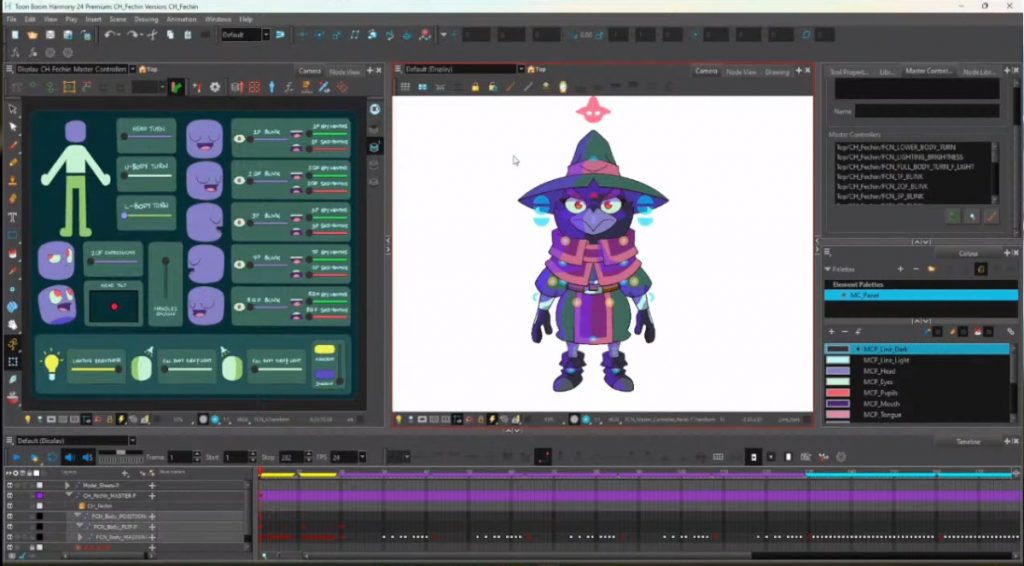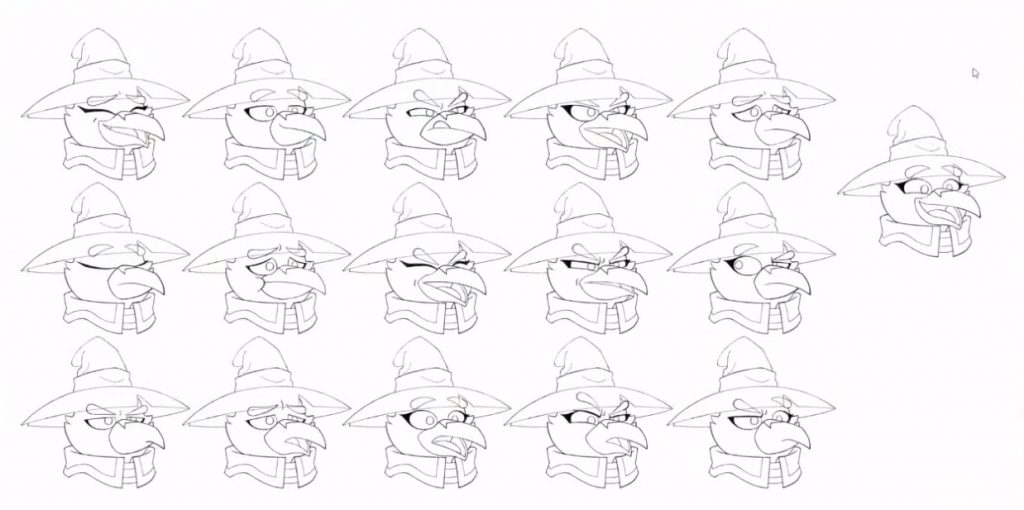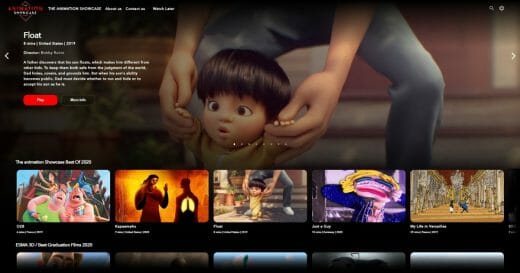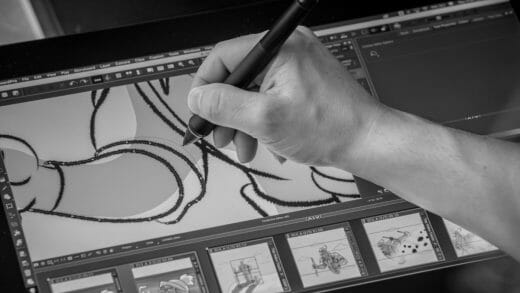
Seth Lanki is a character designer, rigging artist, and 2D animator from British Columbia. His past roles include working with the likes of Relish Studios, Copernicus Studios and Yeti Farm. We came across a clip which Seth shared of Fechin; a D&D-inspired raven wizard which Seth designed, rigged and animated.
Inspired by his clip, we met with Seth to chat about his career trajectory, and the creation of Fetchin. Read on to learn about Seth’s journey from animation to rigging, the technical aspects of Fetchin’s rig — including lighting, master controllers, and the challenges of rigging a character with a beak.
This article was adapted from a transcript of our livestream discussion this past August. You can view the full Show & Tell session on YouTube.
Tell us a bit about the different hats you wear. Character design, rigging and animation are very different disciplines. How did you wind up working in all three?
Seth: I’ve moved around a lot in my career. I started out in animation, but on the side I would rig my own characters. I had learned how to rig in college, just by taking a generalist course on how to animate and rig in Toon Boom.
One day one of the supervisors at the studio I was working at noticed and mentioned that there was a production coming up that needed more rigging talent. They asked me if I wanted to be involved and I said yes, not really knowing how rigs were built for full TV production. And so I got thrown into the deep end – doing rigs on my own was one thing, but doing it on a show really changed my outlook on how the rigging process worked. Following that, I ended up doing rigging for a number of years.
Design wise, I fell into it by accident. At my most recent job, there was a hiatus, but they knew I could draw so they brought me on to do designs and do a crash course on how to design characters for production.
How does your experience with rigging and animation influence your approach to character design?
Seth: When I’m designing a character, I do always try to consider how it will function as a rig. My goal is always to balance design with rigging functionality. For example, I know not to put details right on a joint – things like that matter because a detail on a joint can lead to challenges when rigging.
Another thing I avoid is plaid or stripes on a character. Animators hate that!
As an animator and rigging artist, are there other elements in character design that you think about?
Seth: It’s usually simplifying things. I find that characters I enjoy rigging the most have a simplicity to them, but also have details that are important to show who the character is. The designs that I get tired of are the ones where there are so many details that aren’t necessary. You will have a really detailed design, and the rigging will suffer because of it. Then once animation gets it, they have to cut down on how much animation they can do.
It’s always a balancing act, and I try to stay true to the designs as much as possible. I worked on a show called Pete the Cat – Every character had texture which was difficult. But we found a way to rig them so they stayed true to their designs.

The character that I wanted to ask you about was, Fechin, the raven wizard, which you posted a clip of on LinkedIn. What can you tell us about Fechin and the goal you had in mind when designing this character?
Seth: Fechin started as a character for me to build and animate myself. You work on so many production rigs, but once a production wraps, you can’t touch them again. I wanted to have a really solid, production quality rig of my own that I could make stuff with. So I was getting really into D&D, and I thought it would be fun to have a cartoon character in this D&D inspired space. I also thought about the Hanna Barbara cartoons and got inspiration from that.
Once the design is set, you have to think about the technical side of design to prep for rigging. So you go into the turn around phase to understand how the character will look from the front, sides, and back. My personal taste is that I want a character to look great from every angle. I don’t want to restrict a character to looking good in only one view. You always want to put your turn around into a GIF because it will solidify that the character lives in a 3D space.
I want to always improve as a character rigger, and I don’t get to play with draped shawls or fabrics on most characters. So that’s why Fechin has this draped collar and cape. I also have a hand model sheet, so if the animators have this, it means things will stay on model more consistently. When possible, the animators can flip through the hands they need for a scene instead of drawing it each time. I also have mouth model sheets, at least happy and sad mouths. Doing a beak model sheet for the mouth was a challenge, so I just left it at the happy and sad mouths. Once I had those I felt confident enough to bring them into Harmony.
I was most uncertain about the lighting. Lighting in general you don’t tend to see on Harmony rigs. It can be done, but it adds a lot of time, so it’s normally done in post. I wanted to try it in a way that felt good, and not too cumbersome on the animators. I baked the lighting into each pose so it doesn’t have to be tweaked.
What do you find most interesting or challenging about the character design?
Seth: Part of it was the lighting, but aside from that, the face was the hardest. When I rigged the face, I thought, ‘Why did I choose a bird character?’ The beak is so much more difficult than a human mouth. You have to think more about how it will look in each pose. Especially with a really long, protruding beak.
I’ve been thinking about a few characters I would like to build eventually. I have a raccoon and a wolf. I find I start with something small, and then build a world around it. I’ve always wanted to make cartoons for myself, and I had the time and opportunity to do it. It’s a lot of work for any amount of animation. I had tackled a lot of things I had never done before, like background design. I picked up pieces of knowledge from other designers I had worked with before. Designers are always thinking about the small details, and it makes the world feel more real. That’s something I’m trying to get better at.

How has your approach to rigging changed throughout your career?
Seth: I feel like it’s changed a lot. When you start, you lean into everything that the software can do, all the bells and whistles. As you progress, you realize what’s important and what’s not. It’s better to keep things simpler. Beginner rigs tend to use too many cutters and masks, or they don’t use them in the correct way.
As someone with a creative career, do you have advice for staying motivated to work on projects in your spare time?
Seth: It’s difficult to stay motivated to work on your own stuff. The best thing I can say is to try and not get burned out by your 9 to 5 job. Try and resist doing lots of overtime, make sure there is a healthy balance between your job and personal life. No one has the energy to feel creatively inspired after working 10 or 12 hour days. The more I’ve worked, the happier I am with working for a great team instead of working on a big production.

What skills do you think are important for artists interested in pursuing character design and rigging?
Seth: Watch your favourite cartoons and look at the character designs, then analyze why they’ve made certain choices. With TV, it’s all about making the most efficient design. Think about efficiencies so animators aren’t spending time on details.
I recommend a similar approach for rigging. Download a tutorial or free trial, and explore. There is lots of content online, even more than 5 years ago. Younger and younger people are turning out professional quality work. Soak in as much as possible through free resources.
Do you have advice for artists interested in designing characters for character rigs?
Seth: Try to keep things simple. If you’re designing the character, seeing what they look like in 3D space will give you a good idea if it will function well as a rig. When you go into rigging, it makes it easier to pose stuff out.
- Want to see more from Seth Lanki? Be sure to visit his portfolio and follow him on Instagram at @sethlanki.
- Are you ready to get started on your own character rig in Harmony Premium? Artists can download a free 21-day trial of Toon Boom Harmony.



